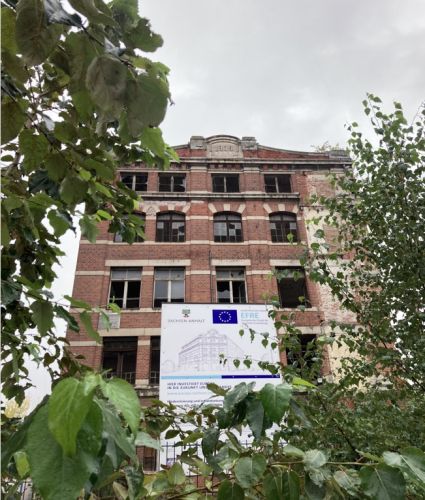
The adoption of the European Green Deal (EGD) represents a turning point in European climate and economic policy. With the EGD, the European Commission initiated the transformation of the European economy towards climate neutrality at the end of 2019. The Commission, and thus all EU countries, undertake to reduce the climate-relevant “net greenhouse gas emissions” to zero by 2050, at least in terms of balance (European Commission, 2019: 2). However, current macro-economic research reports doubts about the feasibility of these ambitious goals and diagnoses an implementation deficit. The passing of new regulations and massive investments in the public and private sectors were not enough to actually achieve the ambitious goals (Wolf et al., 2021).
The EU Commission has also recognized this. In light of the apparent implementation deficit and as part of the solution, the New European Bauhaus (NEB) was constructed in October 2020 as an intersectoral multi-level approach “to go faster and do things better” (von der Leyen, 2019: 9). The role of the EU institutions within the NEB is really remarkable, because for the first time they themselves become actors who try to operationalize the “great transformation” (WBGU 2011, translated by the author) in a project-like manner and to accelerate it through the targeted mobilization of a broad and innovative spectrum of actors. The newly designed, informal set of instruments used is one that has so far only been used by federal states, metropolitan regions or cities and, along with its constitutive elements, is related to the category of “innovative formats of urban and regional development” (e.g. according to Hohn et al. 2014). So far, these have only been indirectly linked to the EU via the structural funds (e.g. ERDF, ESF). The fact that the Commission is now involved in the initiation and implementation of projects at city and municipal level through a curating role and is attempting to initiate new platforms for cooperation and innovation represents a new quality in European policy-making and gives reason to assume that that the NEB is a sign of a changing understanding of control with regard to innovations in spatial development and planning.
Whether and to what extent the new approaches to spatial and structural development lead to new (and permanent) governance arrangements and spatial constructions is to be examined in my work. The reconstruction of sub-processes such as EU policy-making, the efforts of different political levels for a just transition, local strategies of brownfield development and the mobilization of science and culture to find innovative solutions in neighborhood development are carried out with the help of the socio-theoretical strand of politics of scale (see e.g. Moore 2008) and considered “flat” (Marston 2005). This is done in close empirical reference to the “Saxony-Anhalt Project” located in the Central German Revier, one of the diverse initiatives that have been formed across Europe under the umbrella of the NEB. Using the methods of qualitative social research, in particular the approach of “Multi-Sited Ethnography” (Marcus 1995), the actors from the political arenas of the EU, the state of Saxony-Anhalt and Zeitz provide information on how the project-based operationalization of the New European Bauhaus across the levels.
Quellen
Europäische Kommission (2019): MITTEILUNG DER KOMMISSION AN DAS EUROPÄISCHE PARLAMENT, DEN EUROPÄISCHEN RAT, DEN RAT, DEN EUROPÄISCHEN WIRTSCHAFTS- UND SOZIALAUSSCHUSS UND DEN AUSSCHUSS DER REGIONEN – Der europäische Grüne Deal. Brüssel. Online verfügbar unter https://ec.europa.eu/info/sites/default/files/european-green-deal-communication_de.pdf, zuletzt aktualisiert am 01.08.2022, zuletzt geprüft am 01.08.2022.
Hohn, Uta, Jan Balke, und Stadt- und Regionalwissenschaftliches Forschungsnetzwerk Ruhr, Hrsg. Formate der Innovation in der Stadt- und Regionalentwicklung: Reflexionen aus Planungstheorie und Planungspraxis. Metropolis und Region 13. Detmold: Rohn, 2014.
Marcus, George E. „Ethnography in/of the World System: The Emergence of Multi-Sited Ethnography“. Annual Review of Anthropology 24 (1995): 95–117.
Marston, Sallie, J.P. Jones, und Keith Woodward. „Human Geography Without Scale“. Transactions of The Institute of British Geographers – TRANS INST BRIT GEOGR 30 (1. Dezember 2005): 416–32. https://doi.org/10.1111/j.1475-5661.2005.00180.x.
Moore, Adam. „Rethinking scale as a geographical category: From analysis to practice“. Progress in Human Geography – PROG HUM GEOGR 32 (1. April 2008): 203–25. https://doi.org/10.1177/0309132507087647.
von der Leyen, U. (2020): State of the Union Address 2020. European Commission. Online verfügbar unter https://ec.europa.eu/info/sites/default/files/soteu_2020_en.pdf, zuletzt aktualisiert am 01.08.2022, zuletzt geprüft am 01.08.2022.
WBGU (2011): Welt im Wandel – Gesellschaftsvertrag für eine Große Transformation. Hg. v. Wissenschaftlicher Beirat der Bundesregierung Globale Umweltveränderungen. Berlin. Online
verfügbar unter https://issuu.com/wbgu/docs/wbgu_jg2011?fr=sMzhlOTM1OTc5NDI, zuletzt aktualisiert am 01.08.2022, zuletzt geprüft am 01.08.2022.
Wolf, S., Teitge, J., Mielke, J., Schütze, F., & Jaeger, C. (2021). The European Green Deal—More Than Climate Neutrality. Intereconomics, 56(2), 99–107. https://doi.org/10.1007/s10272-021-0963-z
